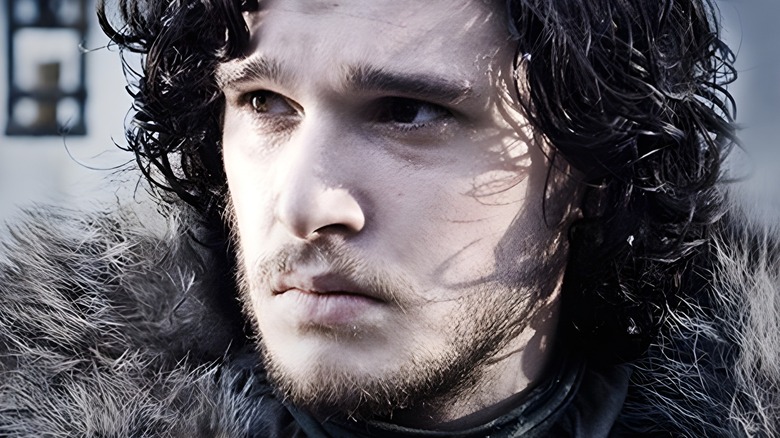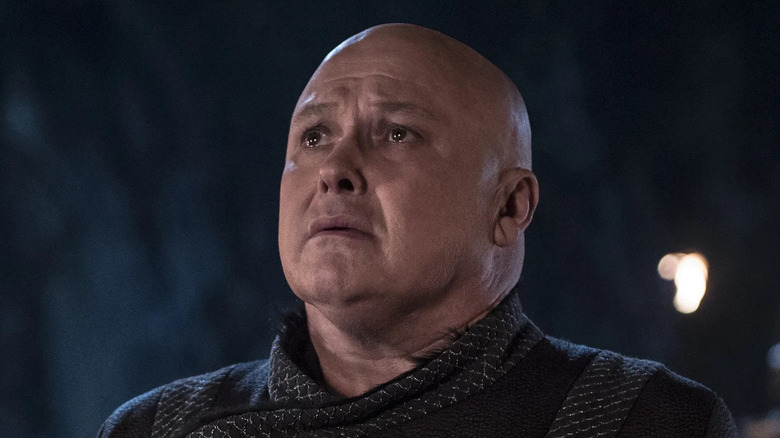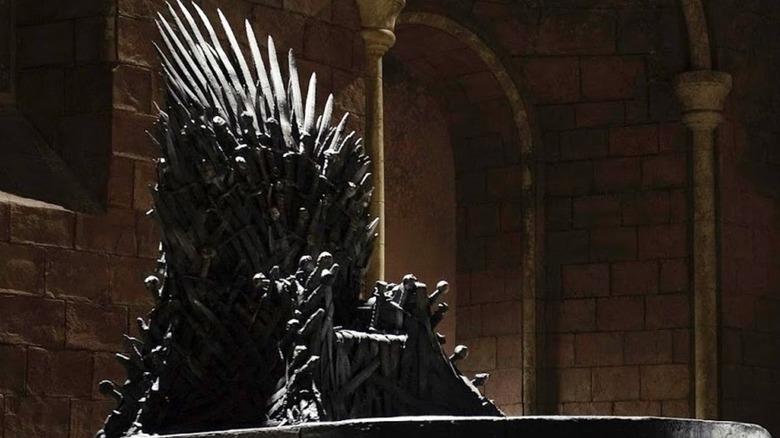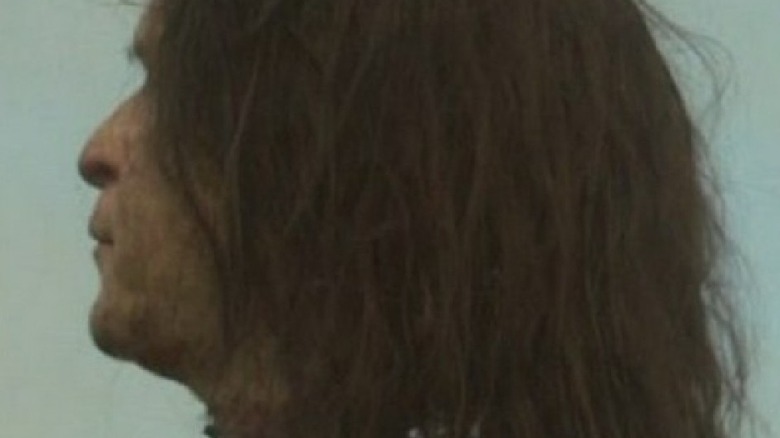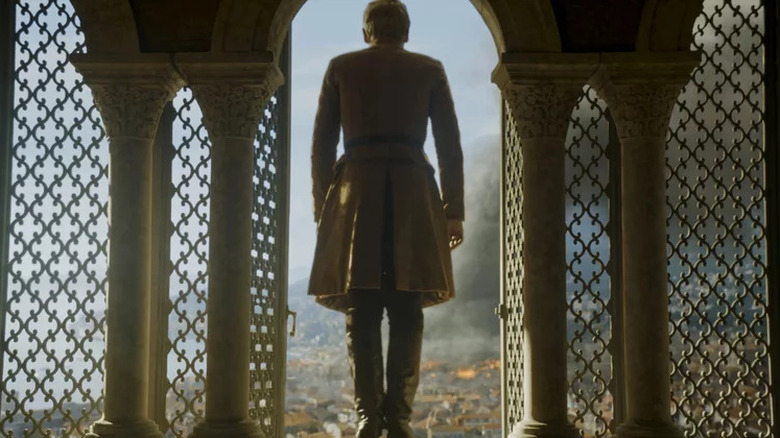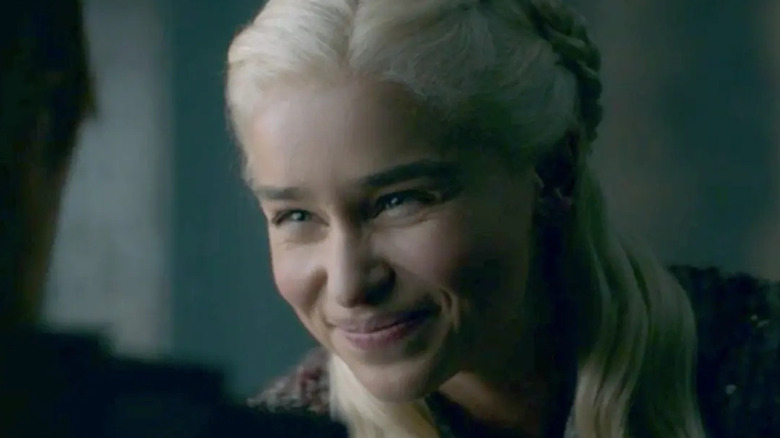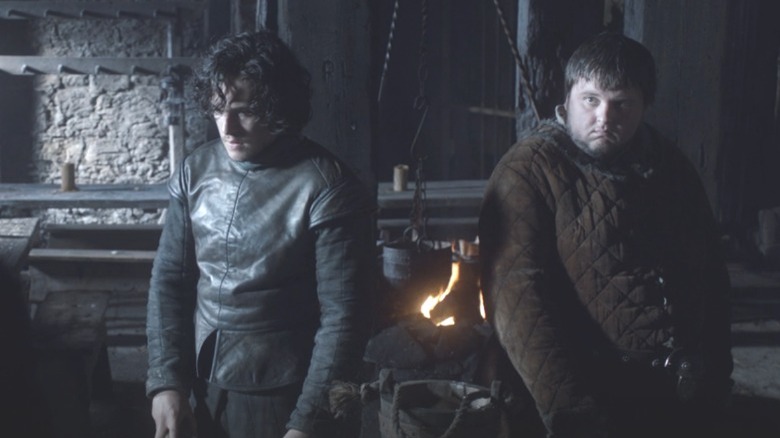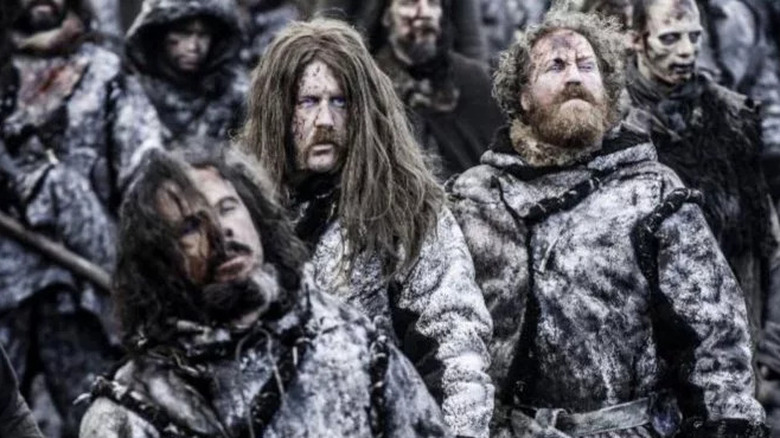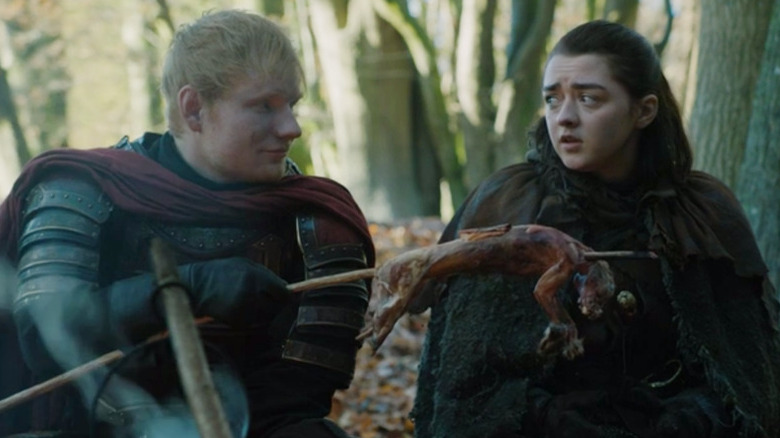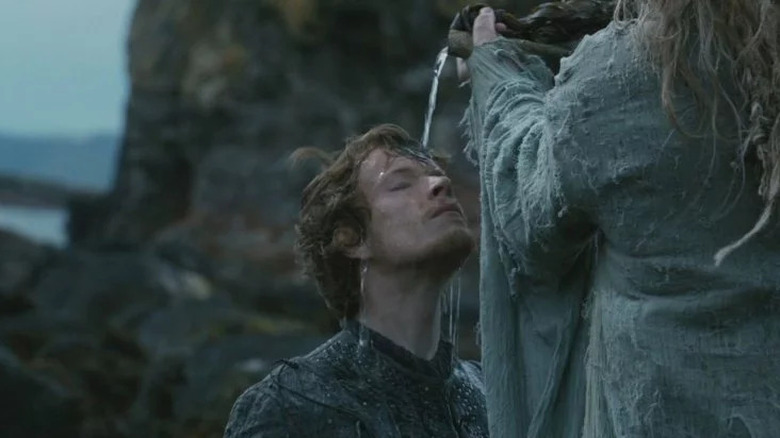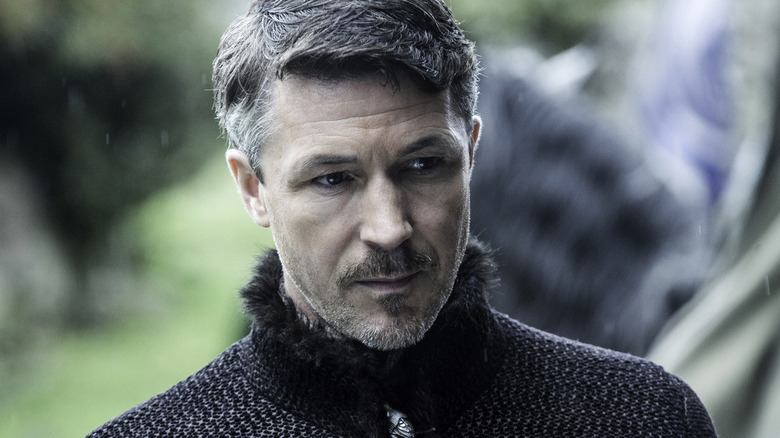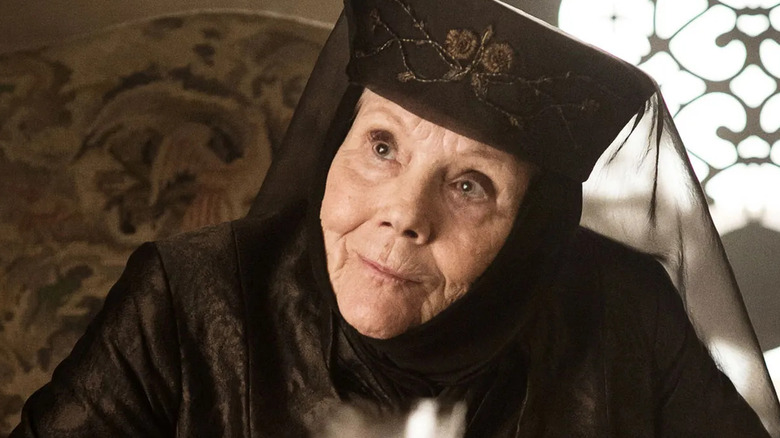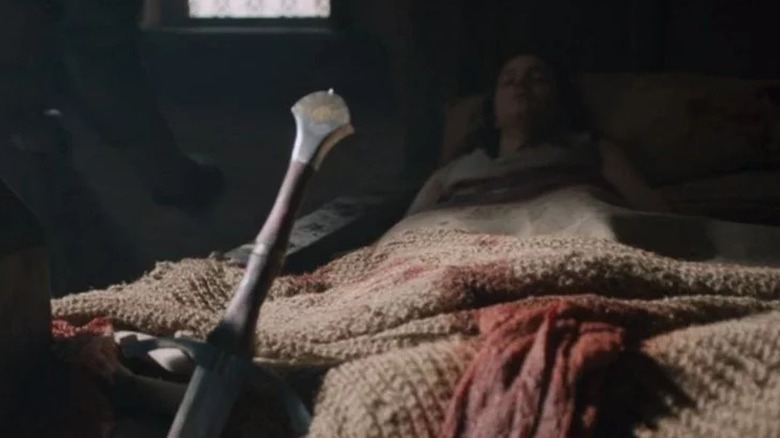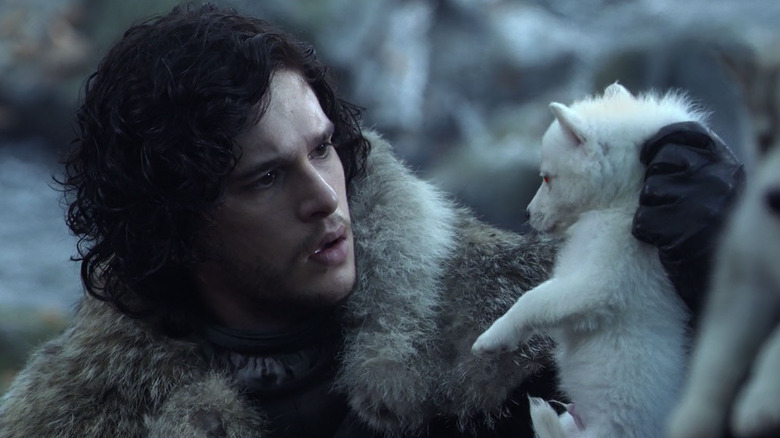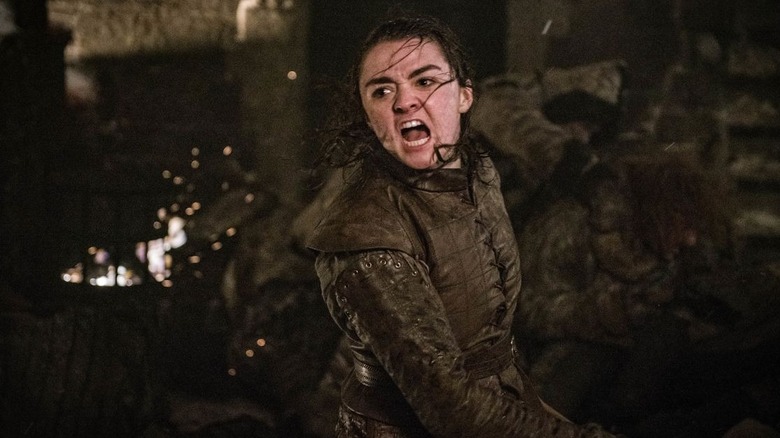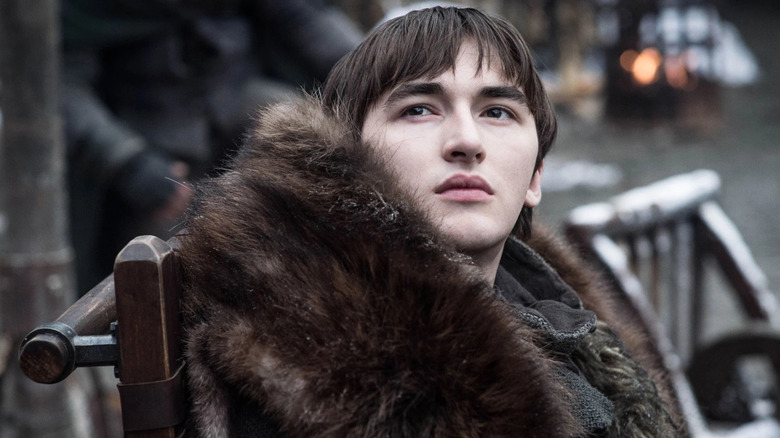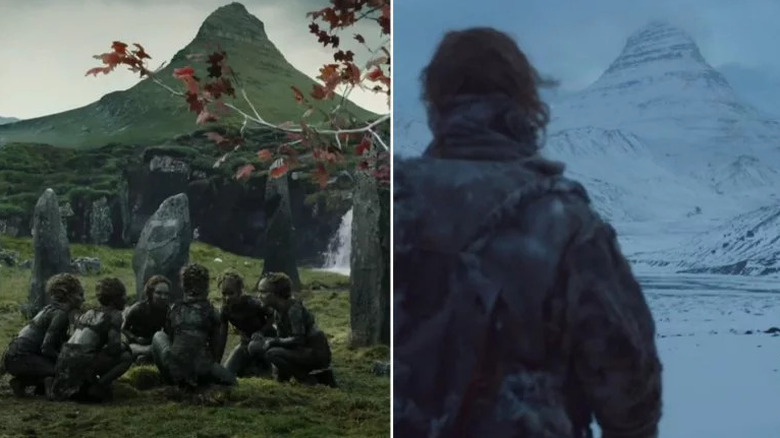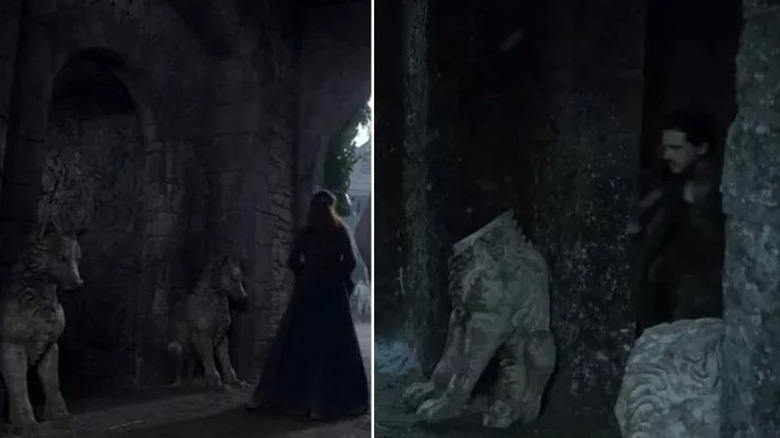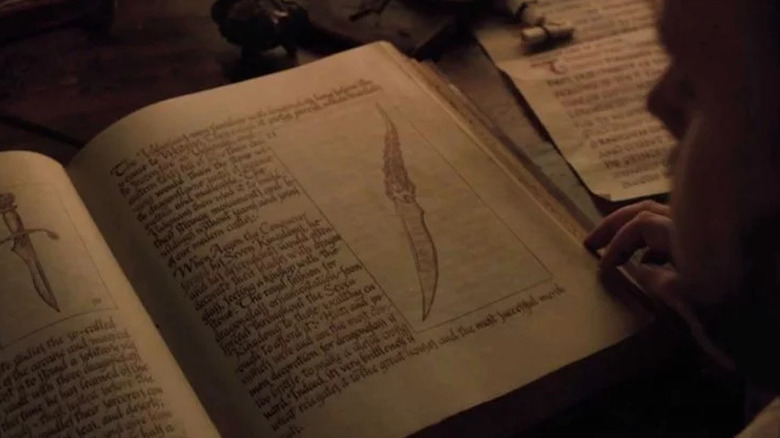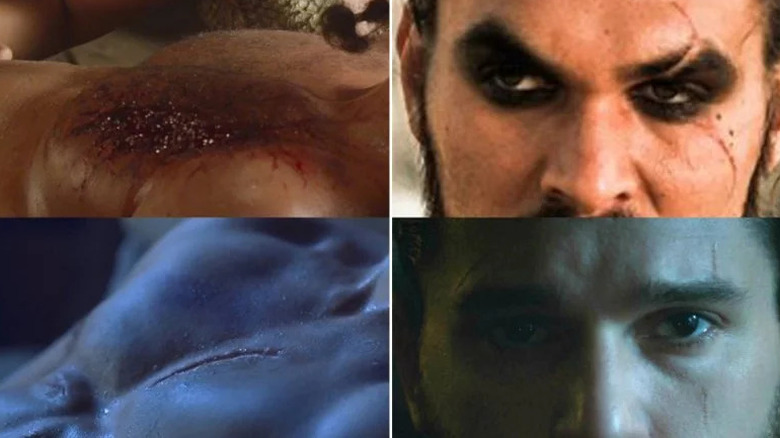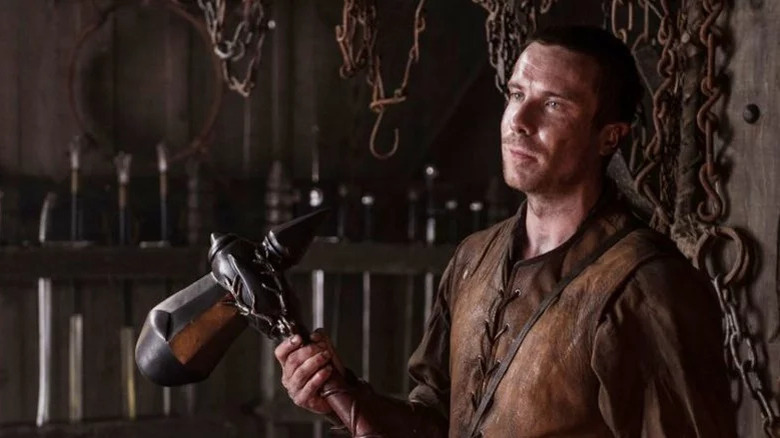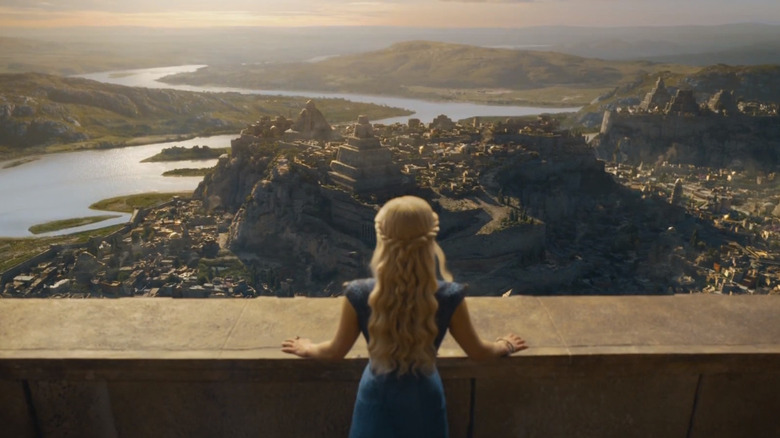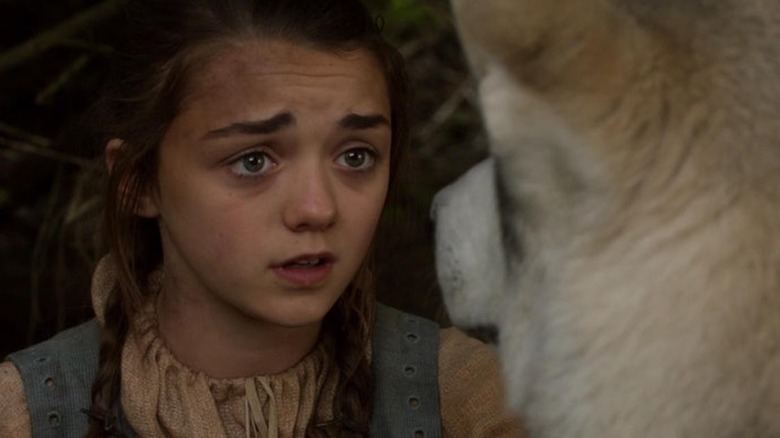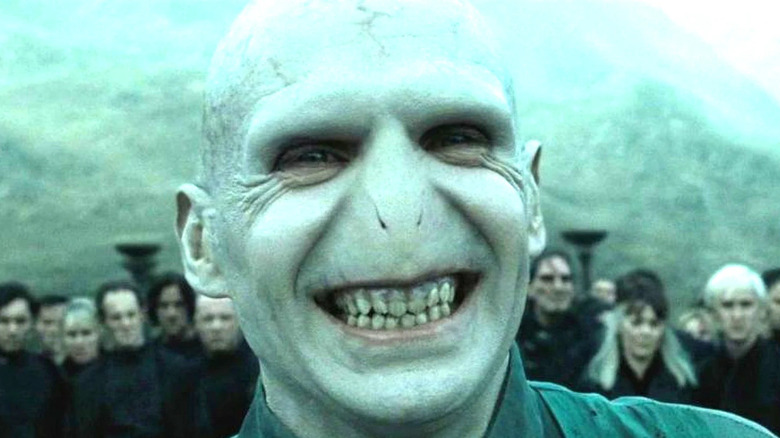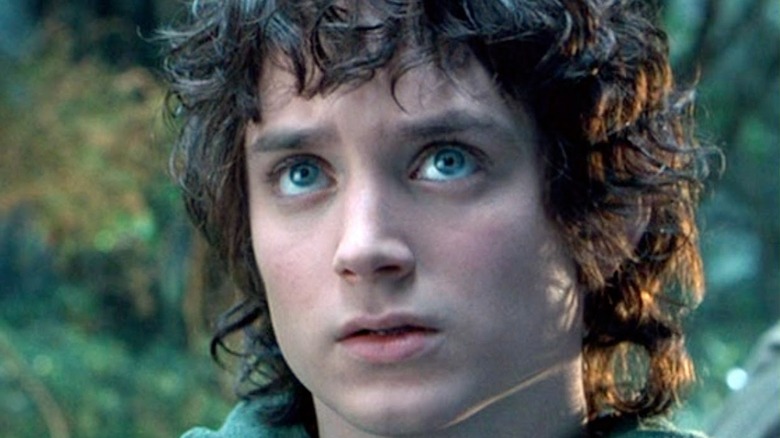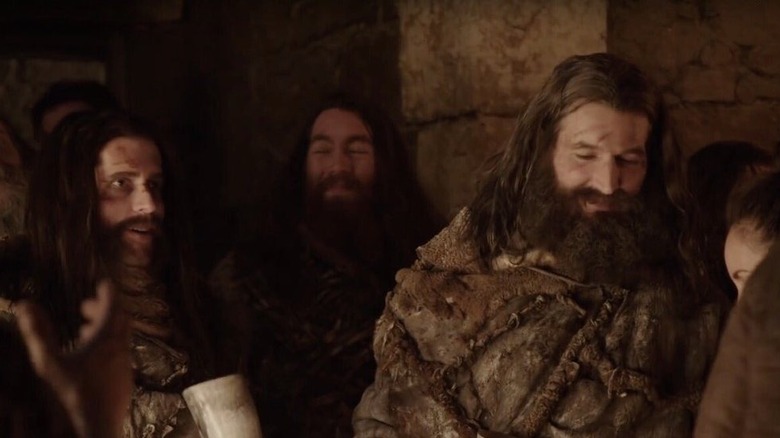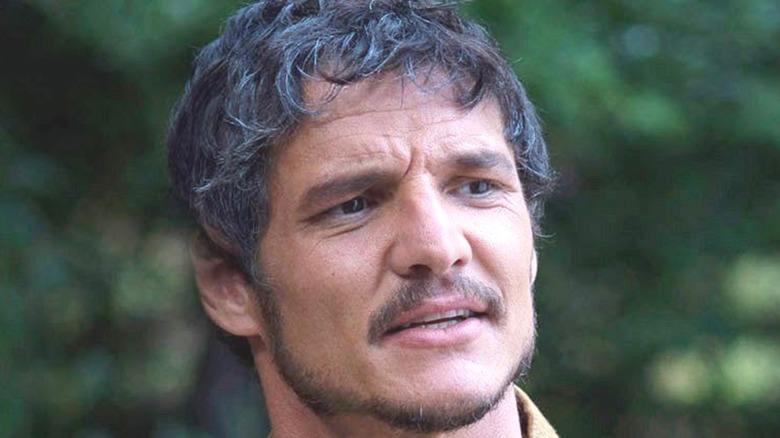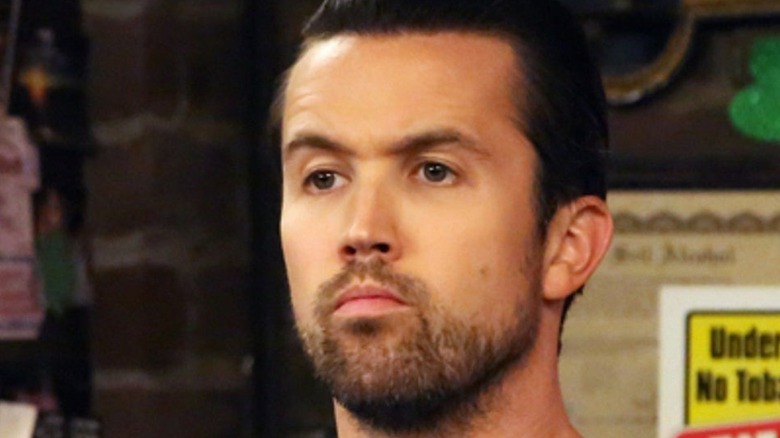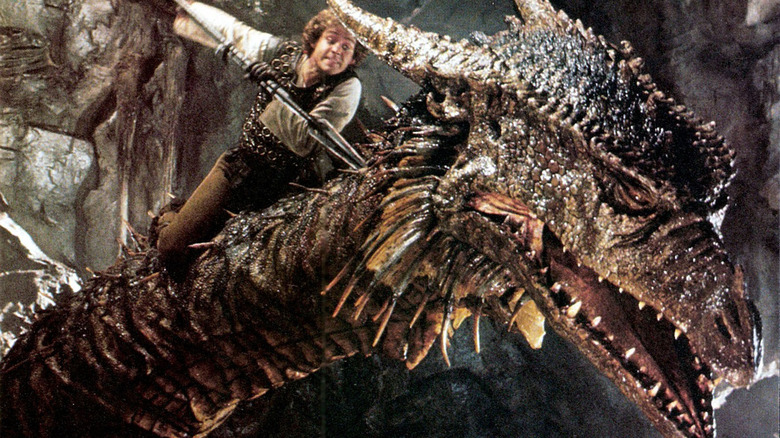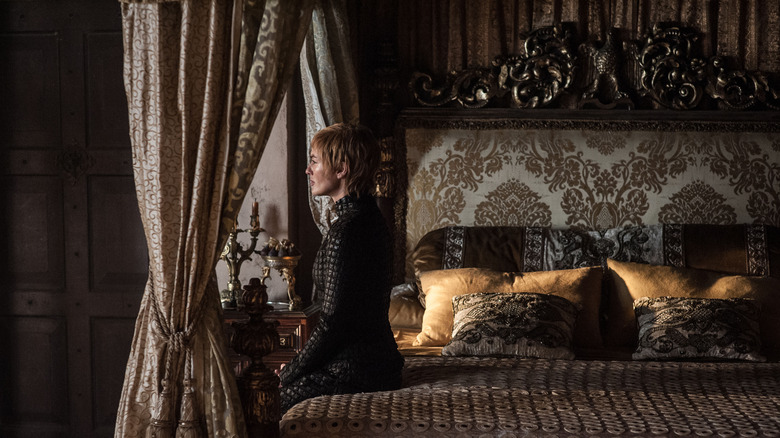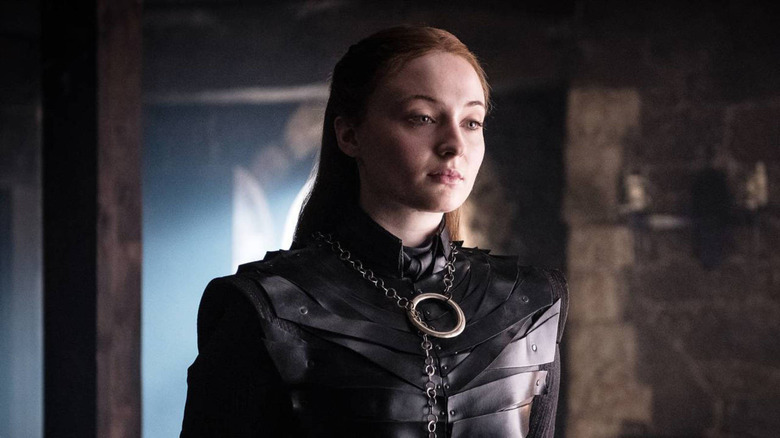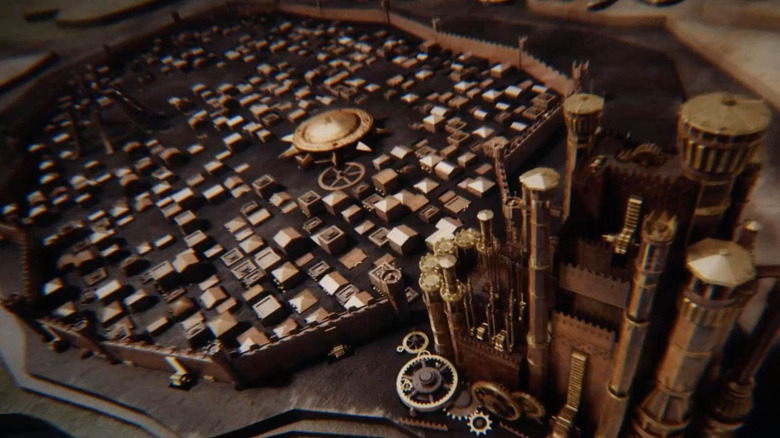Game Of Thrones Easter Eggs You Didn't Notice
Fans of George R.R. Martin's epic fantasy saga "Game of Thrones" have plenty to be thankful for. Between the "House of the Dragon" series and the Jon Snow spinoff, a rewatch of the original show has become a mandatory annual or semi-annual activity for serious fans. And there is more to experience again than just the copious amounts of blood and betrayal — throughout every season of HBO's "Game of Thrones," the showrunners made sure to sprinkle in a liberal amount of hidden clues, references, and Easter eggs for devoted fans to find.
From hints about the future of the plot to references to previous scenes and storylines, the show did a great job of sneaking in stuff where viewers least expected it. In addition to self-referential items and nods to the "A Song of Ice and Fire" books, "Game of Thrones" also managed to hide many references to other books, films, and television shows along the way. Let's take a look at some of the "Game of Thrones" Easter eggs you probably didn't notice, and the hidden meanings behind some you did.
Size doesn't matter
In the books, the Iron Throne is a monstrosity, sitting over 20 feet tall and made from the blades of thousands of opponents vanquished by Aegon Targaryen. Obviously, a throne that size wouldn't work so well on a television show, so the famous prop used in the Red Keep set is much smaller than the one described in the books. The showrunners knew that might cause a bit of complaining among fans of the novels, so they threw in this fun little bit of meta-dialogue in the Season 3 episode "The Climb" between Varys and Littlefinger:
Varys: "A thousand blades, taken from the hands of Aegon's fallen enemies. Forged in the fiery breath of Balerion the Dread."
Littlefinger: "There aren't a thousand blades. There aren't even two hundred. I've counted."
Sword cameos
Speaking of the Iron Throne, did you know that some of those vanquished foes apparently include Ian McKellen and Orlando Bloom? That's right — eagle-eyed viewers have spotted a few "famous" swords hidden among the generic blades in the Iron Throne. Notably, you can see Glamdring — wielded by Gandalf in the "Lord of the Rings" movies — as well as swords from both "Kingdom of Heaven" and "Robin Hood: Prince of Thieves."
President on a pike
Following Ned Stark's execution at the hands of King Joffrey, the new monarch shows us more of his sadistic streak when he forces Sansa Stark to come and look at her father's head displayed on a pike above the Red Keep. Along with Ned's head, several other members of the Stark household and guard in King's Landing are also stuck on spikes nearby. Apparently, onetime U.S. President George W. Bush was part of the Stark retinue, because his head was impaled on a pike right next to Sansa's old septa.
Showrunners David Benioff and D.B. Weiss explained that the use of President Bush's head wasn't intentional but rather a budget issue of just using whatever prop heads were available at the time. Nonetheless, some viewers took issue with the scene, which prompted HBO to issue an apology and digitally edit the face on the head to make it less recognizable in future DVD releases.
The two pillars
Originally said by Cersei in the Season 5 episode "High Sparrow," this quote would become a recurring theme throughout Season 6: "The faith and the crown are the two pillars that hold up this world. One collapses, so does the other." Later, the High Sparrow would relate this quote to Tommen, who then used it himself multiple times, such as on the steps of Baelor's Sept when he announced the union of the Faith and the Crown, and later, when he stripped Jaime Lannister of his Kingsguard title.
"If one crumbles, the other falls." This proverbial saying foreshadows the eventual demise of both the Faith and the Crown in the Season 6 finale. The Great Sept of Baelor literally crumbles to dust from the wildfire explosion, which is followed shortly afterward by Tommen deliberately falling from a Red Keep balcony to his death. His death scene also contains a visual Easter egg referring to this quote, as the camera stays trained on the pillars of his balcony throughout the scene.
Monty Python references
George R. R. Martin is a known fan of the British comedy troupe Monty Python — particularly their movie, "Monty Python and the Holy Grail." References to the film are sprinkled throughout the books, and the showrunners made sure to include some in the television series as well. In the Season 4 episode "Breaker of Chains," Daenerys arrives at the city of Meereen with her army of Unsullied. The Meereenese send out a champion, who hurls several Ghiscari insults at the Dragon Queen before Daario beheads the poor fool. According to show linguist David Peterson, the beginning of his speech translates as: "Your mother was a hamster and your father smelt of elderberries" a direct (translated) quote from the French Taunter in "Monty Python and the Holy Grail."
During Season 1, Doune Castle in Scotland was used as a filming location for Winterfell scenes. This castle has been featured in many other productions, including "Holy Grail," where it was used as "Castle Anthrax." Additionally, when Shireen is teaching Davos to read, she scolds him for mispronouncing the word "knight" as "ka-nig-it," which is another reference to John Cleese's French Taunter in "Holy Grail."
Rhaegar and Lyanna
Long before the Tower of Joy scene in the Season 6 finale finally confirmed the long-held fan theory that Jon Snow is the son of Rhaegar Targaryen and Lyanna Stark, "Game of Thrones" made a sneaky reference to the theory with a set piece. In the Season 1 episode "Cripples, Bastards, and Broken Things," Jon Snow and Samwell Tarly are scrubbing a table and joking around about their past experiences with women. Additionally, Jon reveals that he doesn't know who his mother was. If you watch closely during a scene from episode 4 of season 1, you can see the letters "R" and "L" carved into the post that Jon is standing next to (as shown in the screenshot above, on which we've turned up the brightness), which seems to tease us by confirming the idea that R+L = J.
Rock star cameos
On several occasions, famous bands or musicians found their way into "Game of Thrones" in cameo roles. Coldplay drummer Will Champion played a percussionist in the group of Frey musicians at the Red Wedding, whilst Sigur Ros made an appearance as another set of minstrels at Joffrey and Margaery's Purple Wedding. Gary Lightbody, the singer from Snow Patrol, made a cameo as a singer with Vargo Hoat's "Brave Companions" in Season 3. Finally, the rockers of Mastodon got an enviable and totally metal scene as wildlings at Hardhome who get brutally killed before rising again as the wight thralls of the White Walkers.
Mastodon made a return to the series in the Season 7 finale. You can briefly spot their wight personas standing among the army of the dead as the Night King melts the Wall with an undead Viserion's blue flames. Additionally, singer-songwriter Ed Sheeran made waves with a controversial cameo in the first episode of the seventh season, playing a friendly Lannister soldier named Eddie whom Arya encounters on the Kingsroad.
The death of Ed Sheeran
Musician Ed Sheeran's Season 7 cameo as the Lannister soldier Eddie was poorly received. Many viewers thought Sheeran's presence felt shoehorned in, and ultimately crippled the show's sense of verisimilitude, resulting in a multitude of scathing reactions and comments. In response, Sheeran even told Buzzfeed, "I definitely think they should've killed me off in the episode. I reckon that probably would've been the redemption for people that didn't like it." The good news for fans, critics, and Sheeran is that their collective wish came at least partially true in the form of a subtle reference during the Season 8 premiere.
The Easter egg comes during the scene in which Ser Bronn is in bed with three courtesans. While they disrobe, the three women recount some of their favorite Lannister men who either never came home from war or, in Eddie's case, came home horribly disfigured. They refer to Eddie by name, even calling him "the ginger," and one claims that he "came back with his face burned right off. He's got no eyelids now."
George R. R. Lovecraft
Martin has sprinkled in many references to other authors, books, and series into his works. One of the more prominent among these is the series' homages to H.P. Lovecraft and his Cthulhu mythos. House Greyjoy and all Ironborn follow the religion of the Drowned God, which strongly borrows from the story of Cthulhu. The Drowned God resides in a watery hall below the sea, much like Cthulhu, and is the enemy of the Storm God who lives in a hall in the clouds, much like Cthulhu's arch-rival Hastur the Unspeakable. Even the Drowned God rite — "What is dead may never die, but rises again, harder and stronger" — strongly echoes this couplet from "The Call of Cthulhu," which Lovecraft described as a quote from the mythical Necronomicon: "That is not dead which can eternal lie. And with strange aeons even death may die."
Littlefinger, big predictions
Remember that time when Littlefinger gave away the rest of the season's major deaths in a single sentence? In the Season 4 episode "The Mountain and the Viper," Littlefinger gives some sage advice to Robin Arryn at the Eyrie, telling him, "People die at their dinner tables. They die in their beds. They die squatting over their chamber pots. Everybody dies sooner or later." The first part is clearly a reference to King Joffrey, who was already dead at this point. But the latter two refer to events that Littlefinger could have no foreknowledge of unless he's psychic. Later that season, Tyrion would kill his former lover Shae in a bed, and his father Tywin while he was squatting over his chamber pot. Thanks for the spoilers, Baelish.
100 red scorpions
After Cersei's destruction of the Sept of Baelor and most of the remaining members of House Tyrell, the Queen of Thorns — Lady Olenna Tyrell — makes a visit to Dorne to find some unlikely allies. She begins the conversation by pointing out that the last time a Tyrell came to Dorne, he was assassinated with 100 red scorpions. For most show-only watchers, this anecdote probably didn't mean much, but it was actually a fun Easter egg for fans of the novels.
Oberyn Martell relates the tale to Tyrion in "A Storm of Swords": "When the Young Dragon conquered Dorne so long ago, he left the Lord of Highgarden to rule us after the Submission of Sunspear. This Tyrell moved with his tail from keep to keep, chasing rebels and making certain that our knees stayed bent. He would arrive in force, take a castle for his own, stay a moon's turn, and ride on to the next castle. It was his custom to turn the lords out of their own chambers and take their beds for himself. One night he found himself beneath a heavy velvet canopy. A sash hung down near the pillows, should he wish to summon a wench. He had a taste for Dornish women, this Lord Tyrell, and who can blame him? So he pulled upon the sash, and when he did the canopy above him split open, and a hundred red scorpions fell down upon his head. His death lit a fire that soon swept across Dorne, undoing all the Young Dragon's victories in a fortnight. The kneeling men stood up, and we were free again."
Definitely not a good way to die, although it might be better than having your head crushed by the Mountain or getting blown up with wildfire by the Mad Queen.
Born under a bleeding star
When the young Ned Stark enters the Tower of Joy after defeating Arthur Dayne, he leans Dayne's sword up against the foot of Lyanna's bed as he approaches her. For book fans who were eager to see a glimpse of the fabled sword Dawn, the camera lingers for a moment on the bloody sword. Beyond this visual Easter egg, for some "Game of Thrones" theorists, the presence of the sword at Jon's birth lends credence to the theory that Jon Snow is actually Azor Ahai — the Prince that was Promised, "Born amidst salt and smoke, beneath a bleeding star." As readers will be quick to inform you, the Dayne ancestral sword of Dawn was supposedly forged from the heart of a star, and the sword is most definitely covered in blood. Is it a stretch? Possibly. But what else did fans have to speculate about once Jon's parentage was finally made clear?
The White Wolf
When Jon Snow is crowned King in the North, Lord Manderly dubs him the "White Wolf." This Easter egg references a couple of different aspects of Snow's upbringing. Obviously, the White Wolf is a nod both to Jon's pet dire wolf, Ghost, as well as to his own last name, Snow. But for "Game of Thrones" heraldry fans, the name has an even deeper meaning. Bastards are not allowed to take up the sigil of their family house unless they have been legitimized. In most circumstances, a bastard who wants to establish their own sigil will use the sigil of their house, but with the colors reversed.
If Jon wanted to do this himself, his new sigil would be a white wolf on a field of gray. Of course, after the Season 7 finale revealed that Jon's real parents — Rhaegar and Lyanna — were married, viewers knew Jon is no bastard at all and his actual sigil is the red-on-black three-headed dragon of the Targaryens.
Payback's a bitch
For horrified fans of House Stark who watched the downfall of Robb and Catelyn at the Red Wedding, revenge couldn't come soon enough. It took several seasons, but the payback was truly worth the wait. During the Red Wedding, Robb Stark's wife is stabbed in the belly by Roose Bolton, Catelyn has her throat slit by Black Walder Frey, and both Robb and his dire wolf Grey Wind are killed with crossbows. The deaths of the Red Wedding conspirators match those of their victims — Tywin Lannister is shot with a crossbow, Roose Bolton is stabbed in the gut, and Walder Frey's throat is slit by Arya Stark. For the Stark family, justice is both poetic and sweet.
The Rat Cook
While staying at the Nightfort along the Wall with Jojen, Meera, and Hodor, Bran relates the ancient tale of the Rat Cook, as told to him by Old Nan. Hundreds of years ago, an Andal king was visiting the Nightfort with his son. A cook at the Night's Watch castle was angry with the king for some supposed wrong and murdered the prince and baked him into a pie with bacon, which he then served to the king. The king was so pleased with the pie that he asked for a second piece. According to the legend, the old gods were so outraged by this that they cursed the cook, turning him into a giant white rat that can only survive by eating his own young. Supposedly the rat still roams the Nightfort today.
According to Old Nan, "It was not for murder that the gods cursed him, nor for serving the Andal king his son in a pie. A man has a right to vengeance. But he slew a guest beneath his roof, and that the gods cannot forgive." The tale is still told in Westeros as a warning as to what happens to those who break guests' rights — like Walder Frey. His eventual demise echos many aspects of the story. Before killing him, Arya Stark kills two of his sons and cooks them into a pie, which she then serves to Walder Frey. It isn't obvious in the scene, but if you look closely, you can see that Walder already has the scraps of one piece of pie on his plate, and the piece that Arya brings him is his second. Revenge is truly a dish best served cold — and full of dismembered toes.
The mountain beyond the Wall
During Season 7, a mountain that "looks like an arrowhead" became a pivotal landmark when Jon and his band of merry men went beyond the Wall in search of a wight to capture. Seen by Sandor Clegane during a vision, the mountain is used by the group to guide them on their journey. It wasn't the first time we'd seen the mountain on the show, however — it also loomed in the background of Bran's Season 6 vision, when he watched the Children of the Forest create the first White Walker. At that point in time, the area surrounding the peak was lush and green, not the frozen tundra it is now. In reality, this mountain is called Kirkjufell ("Church Mountain") and is a popular landmark in Iceland, where a large portion of "Game of Thrones" is filmed.
The Winterfell crypt guardians
Although Ramsay Bolton (and the rest of the Bolton clan) are now dead and gone, the damage they did to the Stark family goes much deeper than psychological trauma. We got a glimpse of that trauma in the second episode of Season 7, when Jon leaves the Winterfell crypt after a tense conversation with Littlefinger. If you were paying attention, you may have noticed the headless statues standing guard outside the crypt's entrance.
What's the significance of these broken guardians? As seen in Season 1, two sturdy and detailed dire wolf statues stood on either side of the crypt entrance. Theon Greyjoy may have held Winterfell with his Ironborn for a brief time, but it wasn't until the Boltons took up residence that these statues were desecrated. The Boltons were trying to replace the Starks as the new power in the North, and by beheading the statues, they were reminding the people of Winterfell who was in charge. In addition, these beheaded statues underscore for the viewer what has been lost; the remaining Stark siblings have been reunited, but so many others have died. In fact, two of those deaths — Robb's and Rickon's — came directly at the hands of the Boltons, making this an even more poignant reminder.
Arya's dagger
During the course of Season 7, a certain Valyrian steel knife known colloquially as the "Catspaw dagger" came into play on multiple occasions. First, Littlefinger gave the knife to Bran, who then passed it on to Arya. As Sansa explained in the season finale, Littlefinger told Catelyn that the dagger had belonged to Tyrion Lannister, which caused Catelyn to kidnap Tyrion, Tywin Lannister to go to war, and Jaime Lannister to attack Ned Stark in the streets of King's Landing. In reality, it was Littlefinger's dagger, and his lies had been designed to create chaos. But the story of this particular dagger actually goes back much further.
When Samwell Tarly is researching Dragonglass in Oldtown, he flips through the pages of a book about the topic. Actor John Bradley told the Huffington Post that during the scene, he was directed to "linger on this page" so audiences could get a good look, signifying that the reference is an important one. On one page is an illustration of the Catspaw dagger, with text indicating that it's made of Valyrian steel with Dragonglass ornamentation — meaning, it's made of the two materials that can kill White Walkers. Another clue hidden on that page suggests that the Catspaw dagger may once have belonged to Aegon the Conqueror himself. When Bran received the dagger from Littlefinger, he asked him, "Do you know who this belonged to?" This question has much more meaning now that we know it may have been Aegon I's, and that Jon's true name is also Aegon Targaryen.
And the dagger's long, bloody history may yet continue, as the weapon seems to make an appearance in a trailer for "House of the Dragon," wielded by a member of House Hightower.
Jon's Scars
In the Season 7 episode "Beyond the Wall," Daenerys is forced to rescue Jon and his crew when their mission to trap a wight ends with them in the middle of a frozen lake, surrounded by the army of the dead. Unfortunately, Jon gets pulled into the icy waters before Dany can save him. Luckily, he emerges mostly unscathed, and his Uncle Benjen unexpectedly shows up — giving Jon his horse and sacrificing himself to the horde of wights to give his nephew a head start. When Jon arrives back at Eastwatch, he's hypothermic and is quickly brought aboard their ship, where Daenerys watches in horror as she sees Jon's old scars from when he was murdered by the Night's Watch mutineers.
This Easter egg is all about those scars — or rather, their placement. Daenerys' lost love Khal Drogo had a scar through his left eyebrow, as does Jon. Additionally, Drogo died from an infected wound very near his heart, and Jon has a puckered scar in the same place. The similarities between these scars may have contributed to Daenerys' shock when she saw Jon's wounds — it likely brought up horrible memories of how her first husband died. Would she lose Jon the same way? It's clear from the following scene that she'd been sitting at Jon's bedside for hours, just as she did for Drogo when he was near death, hoping against hope that he'd return to her. This time, she got her wish.
Gendry's hammer
Fans rejoiced when Ser Davos Seaworth tracked down Gendry in the Season 7 episode "Eastwatch," and found out that he hadn't actually been rowing for the last four seasons. Instead, Gendry was working for himself in the Street of Steel at King's Landing. When Davos asks Gendry to come back to Dragonstone, Gendry jumps at the chance — only pausing to grab an exquisitely crafted war hammer. Gendry is pretty darn good with it, too, as seen when he smashes in the heads of two nosy Gold Cloaks.
Gendry's war hammer was embellished with a golden stag, which is the sigil of House Baratheon. When Robert was in his prime, he was known for his prowess with a war hammer, which he used to kill Rhaegar Targaryen. It's likely that Gendry knows this, which may be why he made himself the weapon — a reference to his father's favored hammer. What's really fun about all of this is the initial meeting between Gendry and Jon, when Gendry tells Jon, "Our fathers trusted each other; why shouldn't we?" Gendry was referring to Robert and Ned, but we know Jon's real father was Rhaegar Targaryen, and Gendry's father actually killed Jon's.
Westeros is Great Britain and Ireland
A fun fact about "Game of Thrones" that may have eluded even the hardcore fans is that the franchise's world has no official name. In fact, characters in both the books and TV series simply refer to the planet as "the world" or "the known world," with no alternative proposed. That's because George R.R. Martin always intended the books to focus almost exclusively on one of the world's continents. That continent is Westeros, and aside from brief forays into the far western shore of Essos, Westeros is home to all of the events of the series. And, as one observant fan noticed, that home bears an uncanny resemblance to the islands of Ireland and Great Britain stacked on top of another.
Martin himself has always been outspoken about his desire to base his setting on the British Isles, even describing the known world to the crowd at Chicon 7 as "a super-Europe-super-Asia and a giant British Isles, and, you know, like they would have actually known in the Middle Ages," referring to Essos and Westeros respectively. But to see Westeros so neatly aligned with the two largest British Isles is still a striking reference.
Nymeria, that's not you
One way "Game of Thrones" sets itself apart from other fantasy franchises is keeping its mythological creatures comparatively limited in number. There are only a handful of different fantasy beasts that appear throughout the series, and the very first non-human characters to appear – the Stark children's iconic dire wolves — aren't actually mythical at all. Dire wolves were a real species that interacted with humans and went extinct only recently. That fact helps lend a primal, visceral depth to the way the "Game of Thrones" wolves connect with the Starks. It's a joyous moment when Arya and her wolf Nymeria finally reconnect in Season 7, although the pair almost immediately part ways for reasons that might confuse viewers whose memories of Season 1 are a little fuzzy.
When Arya tells Nymeria "That's not you," fans could've gotten the idea that this interaction is a simple case of mistaken identity. In fact, it's a subtle Easter eggs years in the making. Arya isn't claiming to have confused the wolf for her own, but rather calling back to a line of dialogue from Season 1. Back then, she told her father Ned "That's not me" in response to him trying to sell her on the traditionally feminine life of a princess. Just as Arya knew that her path wasn't going to be decided by others, she knew that Nymeria was going to choose her own path as well — even if it meant creating a new family without the young Stark woman.
Is Samwell Tarly Voldemort?
Season 7 contains a subtle but clearly intentional Easter egg meant to reference another beloved, smash-hit fantasy franchise — "Harry Potter." The crux (or should we say "Horcrux") of the reference lies in legendary British actor Jim Broadbent, who played both Archmaester Ebrose in "Game of Thrones" and Professor Horace Slughorn in the "Harry Potter" films. In both cases, Broadbent's characters are academics with access to and authority over library sections. Thanks to Benioff and Weiss's fun Easter egg, both libraries contain a particularly important restricted section.
While seeking knowledge about the White Walkers in Season 7, Samwell asks Archmaester Ebrose about the secret books in the Citadel's restricted section. Likewise, during a flashback scene in "Harry Potter and the Half-Blood Prince," the eventual Lord Voldemort Tom Riddle asks Professor Slughorn about the secret books in Hogwarts's restricted section. Though that is probably the extent of the intended Easter egg, there is a further parallel; Riddle's goal was to master Horcruxes and thereby conquer death, while Samwell's goal was to find a way to destroy the undead — and thereby also conquer death.
Jon Baggins or Frodo Snow?
It's no secret that George R. R. Martin loves J. R. R. Tolkien's work, with the "Game of Thrones" author even claiming that "I yield to no one in my admiration for 'Lord of the Rings.'" Even when Martin finds himself in competition with Tolkien's franchise, such as in the simultaneously airing seasons of "House of the Dragon" and "Rings of Power," he can't help but hope that the Tolkien-inspired show succeeds, even while hoping "House of the Dragon" succeeds slightly more. That's why many fans have been quick to notice certain parallels between Martin's characters and Tolkien's, especially their two main protagonists: Jon Snow and Frodo.
Both are orphans raised by surrogate fathers; both have best friends named Sam and another bestie whose name is Pip, possibly spelled with a "y"; both enter the realm of death after being stabbed only to return via magical intervention; both still feel the mortal wounds they endured years later; both save the world from what is ultimately its greatest evil (sorry, Daenerys); both are unable to find peace or happiness in their newly-saved world, and both eventually leave their normal world to start new lives in a realm of even more fantasy. In the latter case, that's the Undying Lands for Frodo and Beyond the Wall for Snow.
Guest-starring Benioff and Weiss
Anyone who finds themselves in charge of one of the biggest and most beloved fantasy series of all time must feel constant temptation to cast themselves in the show. After spending the majority of their waking moments for years imagining and creating a fictional world, those with the ability to put themselves inside must seriously consider it. For "Game of Thrones" showrunners David Benioff and D.B. Weiss, the temptation was simply too much to resist.
Their first cameo comes when Arya visits the Hall of Faces. Molds of both showrunners' faces appear among the many that fill that ghastly room. As Weiss once revealed, "Both David and myself appeared many, many times in the Hall of Faces... there is at least 20 or 30 of me in there." Because 20 or 30 was evidently not enough, the pair also showed up in the Season 8 episode "The Last of the Starks" as a pair of wildlings at the celebration in Winterfell. Funnily enough, that is the very same scene that contains the infamous coffee cup mistake, which suggests that the two could have better spent their time observing the scene than acting in it.
When Lena Headey tried to warn us
Cersei certainly didn't make the best first impression on "Game of Thrones" viewers by engaging in incest and condoning attempted child murder all within the show's first episode. Despite that despicable introduction, the character somehow managed to become even more hated by the end of "Game of Thrones," thanks to a few dozen more acts of malevolent cruelty. Meanwhile, not only is the actor who brought Cersei to life, Lena Headey, almost certainly not a mass murderer like her character, she even tried to warn us about Oberyn Martell's death a full two months before it happened.
The warning came via a post on the actor's Instagram page in which she jokingly gouged actor Pedro Pascal's eyes out, almost exactly as we saw the Mountain do two months later during the viscerally gruesome killing of Oberyn Martell. The Red Viper of Dorne's death was one of the series' most violent and shocking, enough to even inspire a trend of reaction videos online. Luckily, Headey sneakily and subtly prepared her own fans for the eventual gore fest. Pascal himself waited until after his character died to comment on the incident, hilariously Tweeting "I sh*t you not, I can't get rid of this headache."
It's Occasionally Sunny in Westeros
We've covered a huge number of cameos already, from showrunners to swords to a president to enough musicians to recreate "We Are the World." But one important cameo remains thus far unmentioned: Rob McElhenney, the creator, writer, and co-star of "It's Always Sunny in Philadelphia." Though he's best known for playing Mac on the brilliant and criminally under-awarded FX comedy, McElhenney also landed a role on "Game of Thrones" in the Season 8 premiere.
During Theon's mission to rescue Yara, her loyalists launch a quick, silent assault on the Ironborn ship in which she's held captive. The opening moments of the attack see five Ironborn sailors struck by arrows before they can even react. The first of these sailors is none other than McElhenney, who receives enough of a closeup to confirm his role. However, like so many in "Game of Thrones," McElhenney's character — known only as "Ironborn #1" — was always fated to die. The arrow that strikes him sails through his head and out his eye, killing him brutally and instantly. McElhenney posted his reaction to his performance on his Instagram, captioning it with a perfect "Don't blink."
A Dragonslayer tie-in
If you haven't seen Disney's 1981 live-action fantasy film "Dragonslayer," do yourself a favor and watch it immediately. It's well reviewed, a cult favorite, and an inspiration to many industry professionals. In particular, the film's dragon – Vermithrax Pejorative – has left an indelible mark on some major names. Guillermo del Toro, for one, called the dragon "one of the most perfect creature designs ever made." Another fantasy big-shot who forever has eyes for Vermithrax is the author of "Thrones" himself, George R. R. Martin, who called the creature "the best dragon ever put on film... and has the coolest dragon name as well." D.B. Weiss also shares Martin's love for the wonderfully realistic dragon, which is why he snuck in an Easter egg to reference it in Season 1.
While Viserys is bathing with Doreah, he recounts to her his childhood walking among the skulls of dragons past in the Red Keep. Among the names of long-dead dragons comes — you guessed it — Vermithrax. On the episode's Blu-ray commentary, writer Bryan Cogman confirmed that the homage was Weiss's idea, an intentional nod to "one of the great '80s fantasy films."
The furniture tells the story
Between the characters, dialogue, and plot, there is an absolute surplus of masterful storytelling in "Game of Thrones," so perhaps it's no surprise that the sets themselves contribute to the narrative as well. One obvious example is the dire wolf statues the Boltons beheaded when they took over Winterfell. Another is the many scorpions that line the walls around King's Landing. The massive anti-dragon weapons are clearly built by master smiths, but due to the rushed nature of the city's defense, they sit on platforms made from hastily thrown together wood planks with no railings nor even paint.
Especially as the series goes on and certain locations are conquered by multiple successive factions, the production team made sure that those sets reflected their history. One excellent example is the Red Keep's interior which — despite its long tenure in Lannister hands — is nonetheless festooned with dragon ornamentation, relics of past Targaryen rule. The crypts beneath Winterfell are particularly useful for seeing this approach to set design in action, as they change throughout the series to reflect regime changes, destruction, vandalism, and even the erection of Ned Stark's official memorial statue.
The clothes tell a story, too
Because no part of "Game of Thrones" exists without adding to the show's constant storytelling and world building, even the characters' outfits were designed to convey specific reactions, emotions, and character traits. Speaking with Elle, costume designer Michele Clapton revealed a few of her more noticeable contributions to the final seasons' characters and tone. "Winter has come," said Clapton. "People say 'Where's the color gone?' If the end of the world was coming as you know it, you wouldn't actually be colorful and bright. You'd start being incredibly practical." That shows in many of the female characters' clothes, which gradually shifted from bright colors and flowing fabrics to blacks and grays wrapped tightly around the body.
Clapton also revealed many Easter eggs in Sansa's outfits and the subtle references they make to the character's greatest influences, including her mother and father, and even hinting at the influences Sansa took from Cersei and Littlefinger. The outfits also reflect Sansa's traumas or, as Clapton put it, "I wanted it to look as if she was actually sewn or laced into her dress — like there was no way in... She's trying to protect herself from all the awfulness that's happened." Of course, this is all even more impressive when you consider the fact that some of the wardrobe is just IKEA rugs.
The many secrets of the map
Of all the many facets of "Game of Thrones," from its myriad characters, intricately interwoven storylines, and expansive scope of in-universe history, the series' single greatest source of Easter eggs comes from one surprising place: its opening animation sequence. The sequence, widely hailed as one of the most epic of all time and an Emmy winner itself, travels across the map of the known world and changes from episode to episode with every change adding more Easter eggs for eagle-eyed fans to unearth.
The sequence's many variations share one of the most elaborate pages on the "Game of Thrones" wiki, and with good reason — they not only chronicle the history of the series, but they also tease its future. As Kirk Shintani, part of the team at Elastic that created the sequence, told The Wrap, "As the episodes progress, you know, as the set piece changes, the things that you notice happen later, you might find little hints of those same things in the previous episodes." As a specific example, he cited the revamped Season 8 sequence, saying "everything that is going to be there for all six episodes... those elements will have been in the Season 8 opening credits from the premiere episode."
